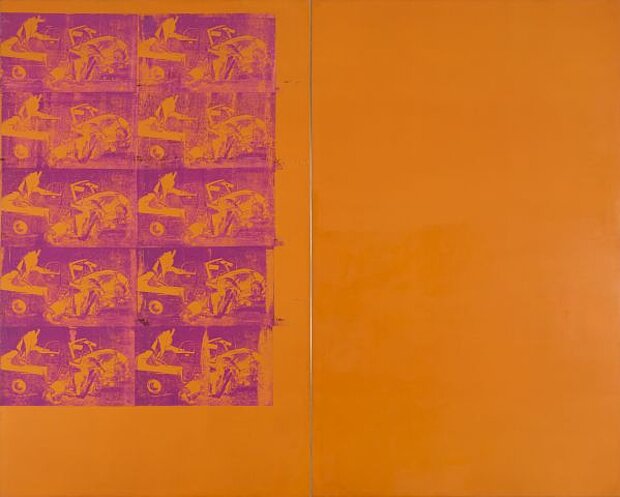
Warhol, Andy
Orange Car Crash
1963

© mumok
| Object description | Acrylic, silkscreen on canvas |
|---|---|
| Object category | sculpture |
| Material |
Support:
canvas
Object:
acrylic paint,
Siebdruckfarbe
|
| Technique |
Object:
screen printing
|
| Dimensions |
Objektmaß:
height: 334,1 cm,
width: 209,2 cm,
depth: 4,4 cm
Rahmenmaß:
height: 334,1 cm,
width: 418,4 cm,
depth: 4,4 cm
Gewicht:
weight: 26 kg
|
| Year of acquisition | 1978 |
| Inventory number | L 223/0 |
| Creditline | mumok - Museum moderner Kunst Stiftung Ludwig Wien, Leihgabe der Sammlung Ludwig, Aachen |
| Rights reference | Bildrecht, Wien |
| Further information about the person | Warhol, Andy [GND] |
| Literature |
Hyper Real Andy Warhol og hans verden, Louisiana Revy 40. Argang Nr. 2 April 2000 Museum moderner Kunst Stiftung Ludwig Wien Warhol Wool Newman.Painting Real DAS PARADOX DES REALEN.ESSAYS ZUR KUNST annees Pop : 1956 - 1968 ; exposition presentee au Centre Pompidou, Galerie 1, 15 mars - 18 juin 2001 |
In 1963 Warhol contrasts the photographs of famous celebrities like Marilyn Monroe with shots of modern catastrophes. Using screen printing, press photographs of car crashes and suicides are turned into the so called Desaster Paintings. [Originalzitat] Those were the kind of elements of violence and death and everyday occurrences that were part of the culture, even though if it might not have been part of the pop culture, but it seemed to be part of the pop culture in the sense that it was part of the media. You got to know about death and disaster through the newspapers. And newspapers were the ingredient, the source for a great number of these paintings”, said Gerard Malanga, a close collaborator of Andy Warhol. Through mass press the anonymous victims of tragic accidents also experience a perverse form of fame. The car crash in particular lets the American Dream become a nightmare: The car as a luxury item that brings us death. "Orange Car Crash" like a wall papers two dimensional pattern shows the disaster in bold colors. Owing to the repetition of ever the same motive the event loses its singularity, dismay loses its authenticity. In the second monochrome tableau the picture is once and for all deprived of its meaning. Neutralized like those photographs that circulate in thousands in newspapers each day. He’s biographer considered this to be the impulse for the disaster-pictures: “ If one looks at the large circulation dailies, the magazines or the weekly newsreels of the early 1960s, the cultural conflicts in America are all clearly reflected there: the deaths on the streets, the race riots, the black terror ? the consequences of conflicts from the 1950s. During the Kennedy era all of this broke out. And this is why Warhol was completely in keeping with the times when he took up explosions and disasters and declared, in November 1963, the month in which John Kennedy was assassinated, that his next exhibition would be called “Death in America”.
© mumok – museum moderner kunst stiftung ludwig wien